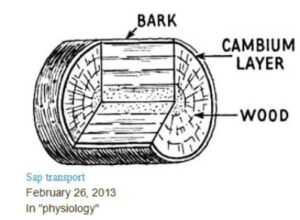
Some books I have read and some YouTube videos I have recently viewed “appear” to promulgate this misunderstanding. Others have caused me to rethink and I present my research for you to use as you wish, as follows.
Basically, there are two types of plant tissues:
- meristematic tissue found in regions of continuous cell division and growth, and
- non–meristematic (permanent) tissue where cells are no longer actively dividing.
Meristematic tissue cells are either undifferentiated or incompletely differentiated; they continue to divide and contribute to the growth of the plant.
In contrast, permanent tissue consists of plant cells that are no longer actively dividing.
Aside: A similar situation exists in our bones, fingernails and hair, whereby the dead tissue is retained and pushed to the outer regions by regrowth. Somewhat similar to our bones, permanent tissue seems to provide structure for the tree.
Meristematic tissue may be one of three types, based on their location in the plant.
- Apical meristems: at the tips of stems and roots, allows plant to extend in length.
- Lateral meristems: facilitate growth in thickness (girth) in a maturing plant.
- Intercalary meristems: occur only in monocots* at the base of leaf blades and at nodes (the areas where leaves attach to a stem). This tissue enables the monocot leaf blade to increase in length from the leaf base. For example, it allows lawn grass leaves to elongate even after repeated mowing.
Aside: Monocots are grasses and grass alternatives and include most of the bulb plants and grains, such as agapanthus, asparagus, bamboo, bananas, corn, daffodils.
However, most scientists agree that the division between monocot and dicot is a fuzzy one.
Meristematic tissue produces cells that differentiate into three secondary tissue types:
- dermal tissue which covers and protects the plant (bark),
- vascular tissue which transports water, minerals, and sugars, and
- ground tissue which serves as …
- a site for photosynthesis,
- support for vascular tissue, and
- a store for nutrients.
Dermal tissue is a simple tissue (composed of similar cell types) that covers the outer surface of the plant and controls gas exchange.
Vascular tissue is an example of a complex tissue (composed of different cell types) and is made of

- xylem tissue which transports water and nutrients from the roots to different parts of the plant.
- cambium which is the “new cell” production layer, and
- phloem tissue which transports organic compounds from the site of photosynthesis to other parts of the plant.
The xylem, cambium and phloem always lie next to each other forming a structure called a vascular bundle in stems, and a vascular stele or vascular cylinder in roots.
Aside: The vascular bundle could be thought of as the plant equivalent of our circulatory system, whereby arteries carry blood, delivering oxygen and nutrients to our body tissue, and then tissue waste matter is removed via veins.
Reference #4 (study.com) gives a great simulation of the workings of the above, BUT, you need to create an account to finish viewing the video.
Plant growth (simplified) is produced by the cambium layer, which produces xylem and phloem cells at varying rates throughout the year. Aussie natives are known to have numerous cycles of these growth spurts yearly.
Xylem is produced on the inside and phloem on the outer (nearer the bark).
At the end of the growing season, the cambium stops producing cells and a growth ring is produced.
The concept of vascular bundles was first touted in 1842, which begs the question …
”why were we not taught this?” My thinking is that the “continuous ring” concept mentioned in the opening paragraphs was far easier to understand and was “near enough” for beginners.
Vascular bundles may be scattered throughout the stem, or in a ring arrangement.
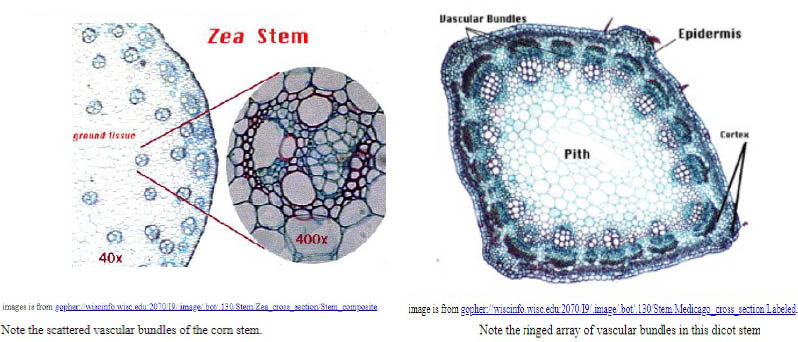
Plant Organ Systems
In plants, just as in animals, similar cells working together form a tissue. When different types of tissues work together to perform a unique function, they form an organ; organs working together form organ systems.
Vascular plants have two distinct organ systems:
- shoot system, and a
- root system.
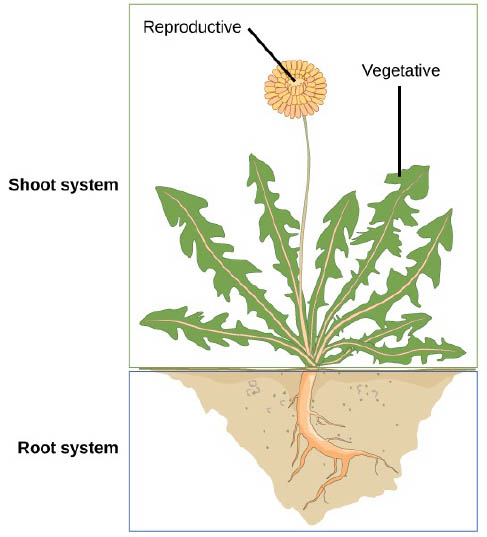
The shoot system generally grows above ground, where it absorbs the light needed for photosynthesis.
The root system, which supports the plants and absorbs water and minerals, is usually underground.
The shoot system consists of two portions:
- vegetative (non-reproductive) parts of the plant, such as the leaves and the stems.
- reproductive parts of the plant, which include flowers and fruits.
Plant Growth Hormones
Plants have two major hormones: auxin and gibberellin.
Auxin promotes the growth of the shoot system whereas gibberellin promotes stem elongation, seed germination, fruit and flowering. Furthermore, auxin plays a role in apical dominance whereas gibberellin has no role in apical dominance.
For the purposes of completion of this article I am only going to give a simplistic view of one role of these hormones and how it relates to Bonsai. There is a plethora of articles on the internet if you wish to go further.
When a plant grows, one bud at the top (apex) of the tree will power ahead of the others, hence the term “Apical dominance”. In doing so it produces the hormone auxin which prevents the side (lateral) buds from emerging. This allows the plant to put all its energy into growing up through the forest canopy toward sunlight as fast as possible.
We interrupt this growth when we tip prune or pinch out upward growing shoots. The result of this action is that we reduce/remove the production of auxin and the side shoots are now able to “burst”.
This is where gibberellin appears to take over as it plays a part in elongating the internodal stems hence the process of ramification starts.
When a new bud develops, auxin and gibberellin levels both rise, and the plant continues growing.
Damage Control and Repair
Wounds on trees do not heal in the same manner as human and/or animal’s wounds. That is to say, trees are not able to repair damaged tissue; instead they continue to lay down a new layer of cells with each year’s growth, until the wound is entirely covered over. The length of time that this ‘healing’ process takes depends upon the size of the wound and the overall amount of new annual growth.
Captain Cook thought he had hit a goldmine when he first saw Norfolk Island Pines. They had straight trunks with no branches down low to weaken the timber, and he needed new masts. When his crew cut down a few trees and split them, he saw that they had 4+ branches, periodically spaced along the length of the trunk, in an “opposite” configuration, but broken off within the tree (see diagram). Because they were so close to each other (some less than 1 metre apart) the timber was too weak to be used as masts.
See below for references

Aerial layering
Air layering is an effective propagation method for plants that do not root readily from cuttings, and often lack low-growing shoots suitable for conventional layering. Examples are Magnolia, Acer, Camellia, Ficus, Jasmine, Rhododendron and Azalea, Lilac and Viburnum.
I have always wanted an Illawarra flame tree (Brachychiton). They are too big for suburban backyards, but I figured, not for Bonsai, so I hunted around until I found one.
Aside: they are hard to come by – I tried 6 nurseries
I finally found one which was by no means “good” bonsai material. It had a 1 metre long (vertically) straight stem, poor root development and no branch structure below 90 cm.
I learnt long ago not to gamble unless you can afford to lose – so I paid my $20 for it and am experimenting and hopeful.

I decided to shorten the trunk by aerial layering it.
Aside: I also experimented with callistemon, maple, and citrus and am happy to say I was successful there.
My early attempts at aerial layering were slip shod and I didn’t scrape deep enough into and past the cambium layer.
As can be seen (right), the flame tree healed itself.
Again, with a persimmon (below) I didn’t completely remove the cambium layer. It also has attempted to heal itself, but some root development can be seen.
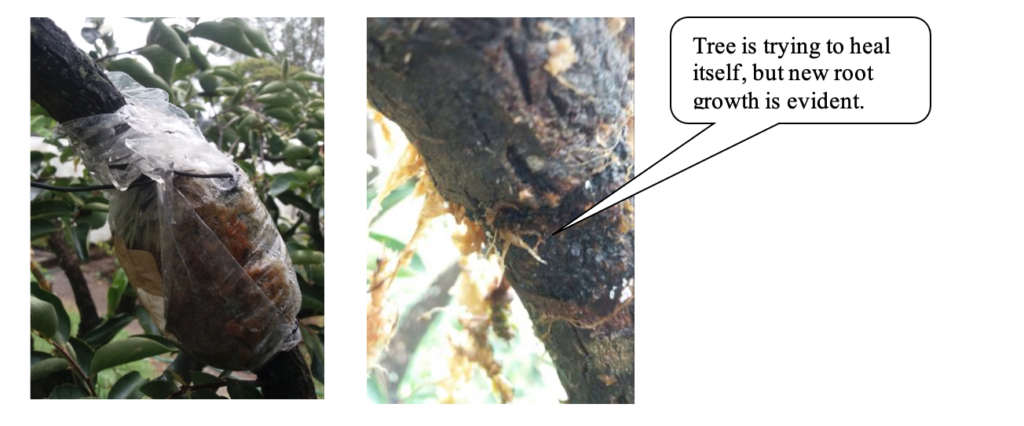
Layering can be carried out in autumn or spring. Deciduous plants apparently respond well in either season, but evergreens respond better to spring layering.
It is currently, by my calendar, mid-winter (15th July 2020) and my Brachychiton is undergoing a surge in growth. Not to be outdone, my mulberry trees are in youthful leaf and full of fruit, and the other morning, on my walk, I saw a magpie gathering up pine needles, so it too thinks spring has sprung. The forecast temperature range for this week is 9 – 23°C. (Brisbane)
On the 12th March, I attempted my first bud graft ever. It too was on the Brachychiton, and recently when I looked it was a VERY healthy green and swelling. I want to remove the growth above, so I am tempted to try air layering it now rather than wait for spring (end of August).
Before starting air layering, I watched numerous YouTube videos on the internet which suggested using black plastic, clear plastic, cut margarine containers, and/or alfoil to wrap the layer with. They also were as varied in their preferred choice of sphagnum moss, peat moss or coir (coconut fibre).
- Sphagnum expensive (almost twice the cost of peat)
- Peat BE CAREFUL: use a dust mask when cutting it and wet it often.
I ended up using a drop saw because it was so difficult. - Coir couldn’t get it at most stores I went to.
I found that during this summer (2019-20), with it’s numerous over 30ºC days, that the plastic wrappers were (almost) too hot to touch, and I guessed that the roots were probably boiling too.
I decided to test wrapping the wrappers with shade cloth or thin foam packaging, or newspaper, and in the case of the persimmon (above), all three.
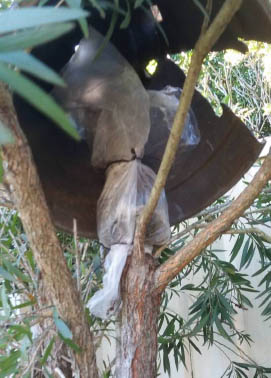
Another thing I found was that clear plastic allowed light through which allowed you to see the root development, but encouraged the growth of algae in the damp conditions inside the sleeve. I currently have an aerial layer, wrapped in clear plastic with a black plastic pot over it to act as sun protection.
Reference #7 below, is a link to Jerry Coleby-Williams (Gardening Australia), who shows his technique for aerial layering plants.
Reference #8 is a link to Jeff Wasielewski of Fairchild Tropical Botanic Garden (American site – so add 6 months to the stated dates) who shows another technique of air-layering.
References:
- https://www.merriam-webster.com/dictionary/vascular%20bundle#h1
- https://www.google.com/search?q=define+vascular+system+in+plants&rlz=1C1GGRV_enAU776AU776&oq=define+vascular+plants&aqs=chrome.6.69i57j0l7.28657j1j8&sourceid=chrome&ie=UTF-8
- https://en.wikipedia.org/wiki/Vascular_bundle
- https://study.com/academy/lesson/vascular-bundles-in-plants-function-types-quiz.html great intro – need to register to finish viewing
- http://www1.biologie.uni-hamburg.de/b-online/library/onlinebio/BioBookPLANTANATII.html
- https://courses.lumenlearning.com/boundless-biology/chapter/the-plant-body/
- https://www.youtube.com/watch?v=ZHgnx5d-3Ic
- https://www.youtube.com/watch?v=qviLRmiqrs8

